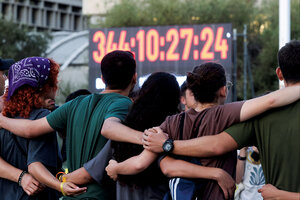After October 7, where do Israel and Gaza look for hope? History shows a way forward.

People sing next to a clock counting the time that has passed since the Oct. 7 attack by Hamas, in Tel Aviv, Israel, Sept. 15.
Jim Urquhart/Reuters
Hope.
That modest goal – the search for a simple ray of light – is at the heart of the Monitor’s powerful cover story marking Oct. 7 and the start of the now yearlong war between Israel and Hamas.
Hope is sustaining people on both sides of the war that began with Hamas’ murder and abduction of hundreds of men, women, and children in southern Israel.
Why We Wrote This
Prospects for compromise between Israelis and Palestinians may seem more distant than ever. But after decades of covering conflict in the region, our columnist finds something even more elusive: hope.
The story explores other parallels as well: a similar sense of personal loss. A feeling of being left undefended, powerless, with the outside world unable or unready to understand or help.
“There is no post-trauma. The trauma is ongoing,” Yara Asi, an academic specializing in the effect of the conflict on Palestinians, is quoted as saying.
And one need only read in the story the remarks of Jonathan Dekel-Chen, father of one of the hostages taken into Gaza on Oct. 7, to understand that he, too, is struggling.
So how to move beyond the trauma? How to rekindle hope for a better future for Israelis and Palestinians alike?
The architecture of any realistic peace arrangement has long been clear.
That’s not because it’s likely to come easily, nor because it’s perfect, but because it’s the only way of addressing both Israelis’ and Palestinians’ core concerns.
It’s the two-state solution, and it’s built on what the late Israeli novelist Amos Oz described as an essential truth about the conflict: that it’s a “clash between right and right.”
Prospects for compromise now seem more distant than ever.
The war that erupted Oct. 7 is being driven by leaders on both sides who reject that very idea. Hamas wants Israel gone altogether. Israeli Prime Minister Benjamin Netanyahu presides over an unprecedentedly right-wing coalition explicitly opposed to Palestinian statehood.
Ordinary Israelis remain shaken by the worst single attack on Jewish civilians since the Holocaust, and the inability of their vaunted army and security services to stop it. Palestinians are reeling from months of Israeli attacks that have left much of Gaza in ruins, hundreds of thousands displaced, and tens of thousands wounded or dead.
Little wonder, then, that in their first joint survey since Oct. 7, leading Israeli pollster Dahlia Scheindlin and Palestinian colleague Khalil Shikaki have found a mirror-image picture of pain.
By far, most Israelis and Palestinians feel their own “persecution and injustice” is incomparable to that of other peoples. For Palestinians, this justifies Oct. 7; for Israelis, the war in Gaza.
And a two-state peace? A mere 31% of Israelis say they still support the idea, and 40% of Palestinians.
Still, the pollsters also make another point – a point of potential hope – that I find resonant from my own nearly 50 years of living, reporting, and writing on both sides of the Arab-Israeli conflict.
It’s that when leaders do show the vision and courage required to explore compromise and peace, opinions on the ground can change dramatically as well.
As Dr. Shikaki put it in a book about his years of joint Palestinian-Israeli polling, “When negotiations became serious, support for violence went down in response.”

